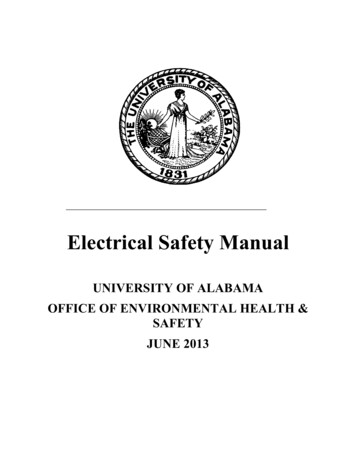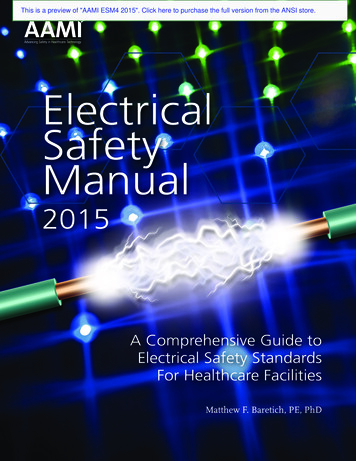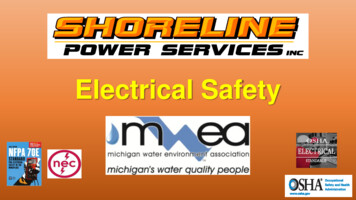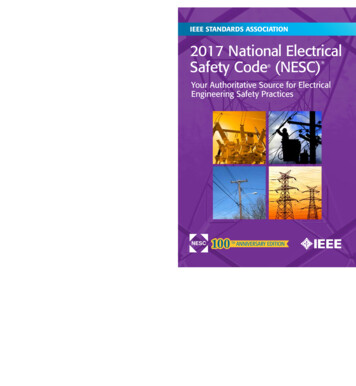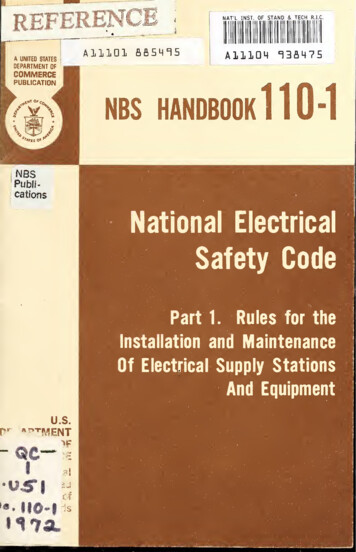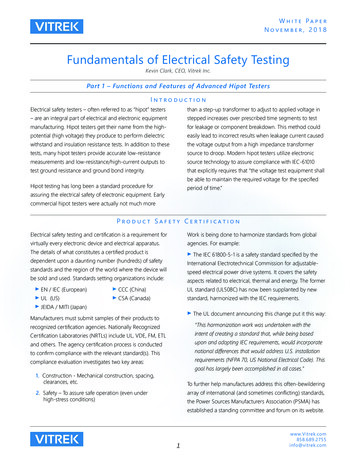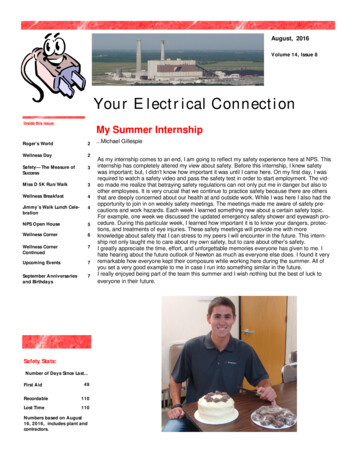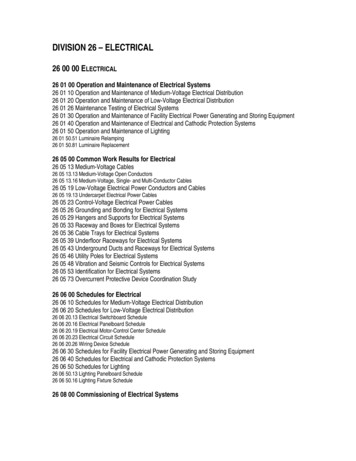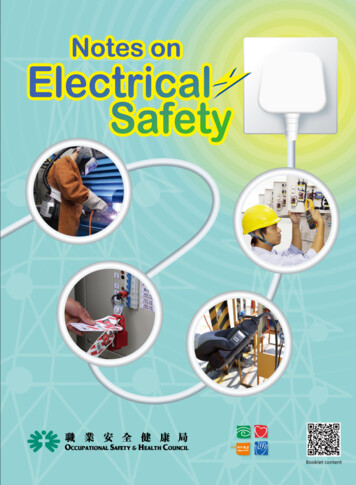
Transcription
ContentsPage1. Introduction32. Electrical safety legislation43. Sources of electricity54. Electricity principles65. Electrical hazards76. Special process (electric arc welding)97. Protective measures for prevention of directelectrical contact108. Safety devices119. Safe use of electricity1310. Installation and maintenance of electrical work1711. First-aid for electric shock18Attachment: Inspection checklist of electrical safety19Note: The information contained in this booklet and the attachment is forreference only, and is subject to any appropriate adjustments related to thesituation of your own working environment. This booklet is also available in Chinese version1
2
1. IntroductionAs a source of power, electricity is used in all aspects of life. In the home and at work, electricityprovides the power for everything from domestic appliances to industrial machines, from officeequipment to electric tools. When compared to the potential dangers of machinery and chemicalsubstances, electrical hazards can be easily overlooked. Unfortunately, this neglect often causes seriousaccidents and loss of property. Many of these accidents can be prevented as they are mainly caused byelectricity users who lack basic safety awareness.3
2. Electrical safety legislationThe legislation involving electrical safety is the “Electricity Ordinance (Chapter 406)” as enforced by theElectrical and Mechanical Services Department and “Factories and Industrial Undertakings (Electricity)Regulations (Chapter 59)” enforced by the Labour Department.2.12.22.34Electricity OrdinanceThe Ordinance requires that people engaged in electricity work, or with contractors and electricitygeneration facilities, must be registered. It also stipulates the safety requirements of electricitysupply, electricity wiring and electrical products, etc.There are several subsidiary regulations of the Electricity Ordinance, including:1. Electricity Supply Regulations2. Electricity Supply (Special Areas) Regulations3. Electricity (Exemption) Regulations4. Electricity (Registration) Regulations5. Electricity (Wiring) Regulations6. Electrical Products (Safety) Regulation7. Electricity Supply Lines (Protection) RegulationFactories and Industrial Undertakings (Electricity) RegulationsThe Regulations apply to industrial undertakings in which electricity is generated, transformed,distributed or used. The purpose is to supervise the safety of electrical facilities and workingprocesses, etc. of relevant industry.Accident StatisticsThese table reviews the industrial accident statistics involving electricity in the past decade.
3. Sources of electricityThe electricity we used is mainly supplied by local electricity companies, and is connected to our homes,working places and other areas, through distribution systems.Frequency: 50 HzVoltage: Single-phase: 220 Volts (V) alternating current3-phase: 380 Volts (V) alternating currentThe electricity used in our homes and offices is single-phase alternating current, and 3-phase alternatingcurrent normally serves the industry.5
4. Electricity principlesOhm’s LawA complete electrical circuit is composed of 3 elements: Current, Voltage and Resistance.ElementUnitAbbreviationVoltage (V)VoltsVCurrent (I)AmperesAResistance (R)OhmsΩTheir correlative relationship can be shown by the following formula:V I x RThe above formula applies to the human body during an electricshock, provided that the voltage remains constant and there isResistance (R) in the human body. A reduction in resistance inthe human body will lead to higher electrical currents passingthrough it, and any injury will be more serious.6
5. Electrical hazards5.1Electric shockElectric shock refers to the electricity passing throughthe human body, affecting the normal function ofthe heart, lungs and nervous system. Ventricularfibrillation caused by electricity is the main reasonfor death from electric shocks. Electric shocks mayindirectly lead to accidents, e.g. falling from heightsand bruising due to body trauma etc.Ventricular fibrillation involves a series of disordered contractions of the heart’s ventricular musclefibres, which prevents regular heartbeat. Under normal conditions, the human heart rate is fromaround 60 to 100 times per minute. During an electric shock, heartbeat may increase up to severalhundred times per minute. When the heart cannot sustain such rapid contraction and relaxation, itmay stop beating and cause death.The effect of currents passingthrough various parts of the bodyRespiratory FailureElectric shock may affectnormal brain function andstop respiration.SuffocationMost accidents due to electricshocks are caused by currentpassing through the chest.When such accidents occur,chest muscles cramp, leadingto suffocation and death.Heartbeat FailureIf current passes throughthe heart, it will disrupt therhythmic pumping actionand eventually stop theheart beat.Unable to get freeafter an electric shockAn electric shock causes continuous contraction of theforearm muscles, thus stopping the victim getting freefrom the electric source.7
5.25.3BurnsDuring an electric shock, the current passing through the body may lead to burns on the skin,muscles or internal organs. As electric shocks and burns are closely related, preventative measuresshould be considered together.Fires and explosionsHigh temperatures caused by currents under abnormal conditions, may result in accidental firesand explosions. The common causes leading to high temperatures include: Overloading of electricity Insulator breakdowns or short circuits Improper contact of electrical circuit Improper maintenance ofelectrical appliances or wiring Poor ventilation, etc.If flames, sparks or metallic solutions due to electric arc welding are not controlled, hazardous fires orexplosions can occur.8
6. Special process (electric arc welding)Electric arc welding is commonly used for metallic welding and cutting. The various hazards fromwelding or cutting include the following:Hazards BurnsSparks or hot metal fragments from arc welding or cutting may result in serious burns. Properprotection is essential. RadiationIf proper eye protectors are not used while welding or cutting, radiation or other objects may hurt thewelder.Safety measures:Wear proper personal protective equipment, e.g. approved eye protectors, hand shields, leather aprons,leather gloves and safety shoes, etc. Electric shockIt is dangerous to conduct the arc welding in a wet environment or on rainy days.Safety measures: Avoid electric welding in such conditions. Earth the tools and equipment properly. Adjust the current required for welding to the minimum amount. Add an automatic voltage regulator to reduce the open-circuitno-load voltage of the transformer output, reducing the chanceof getting an electric shock. Poisonous fumes and gasesInhalation of poisonous fumes and gases during weldingor cutting may cause serious health problems.Safety measures: Provide adequate ventilation. Use exhaust systems to remove poisonous fumesand gases.9
7. Protective measures for prevention of direct electrical contactThe following procedures will prevent the human body from contact with electrical conductors,wiring,electrical sources, etc.Protective measures Insulation Barriers or enclosures Obstacles Placing out of reachShield the electrical conductor with aninsulator to prevent direct contactPlace obstacles to prevent any accidentalcontact with the electrical conductor10Create barriers or enclosures that prevent anydirect contact with the electrical conductorThis prevents accidental contact with theelectrical conductor
8. Safety devices8.1FuseNormally, a fuse is a copper wiring with a set currentfusion value. If the current exceeds the set fusionvalue, the fuse will blow and the current is cut-off, thuspreventing overloading.A fuse must be installed on “live” wires. When replacing a fuse, the new fuse must be samecurrent fusion value as the old one.8.28.3Circuit breakers (MCB)Circuit breakers are based on the principle of the electromagneticfield. The current entered may enable the coils of the circuitbreaker to magnetise. When the current exceeds the set value (i.e.,overloading), the magnetisation intensifies, switching off the circuitbreaker and disconnecting the electric source.EarthingEarthing provides a low resistance way of discharging electricity to the ground in case of currentleakage. This means that during an electric shock, the current passes through the “earth” wire andis prevented from entering the human body and causing injury.11
8.4Earth leakage circuit breaker (ELCB or RCD)Current leakage protection is also called residual current protection or earthing fault current protection.Earth leakage circuit breakers monitor the operation of the “neutral” or “live” wires in the electricalcircuit. During an imbalance in the electrical circuit, or when not all the current flows to the electricalappliance through the “live” wire and returns through the “neutral” wire, part of the current flows away(leaks) into other sources. The earth leakage circuit breaker will immediately detect such an imbalanceand cut-off the electrical source in 0.4 seconds. Rating of the tripping current shall not exceed 30mA.If ELCB is not fixed in main circuit box or the worker works in high riskenvironment (E.g. humid condition), portable RCD(Residual CurrentDevices) should be installed to reduce the chance of getting an electricshock.8.58.612Double insulationPortable ResidualCurrent DeviceAn electrical appliance with double insulation is protected by asupplementary insulation layer in addition to basic insulation. Electricalappliances with double insulation bear the ““ mark. No earthconnection is required for such appliances since double insulation providessufficient protection.Extra-low voltageUsing electrical tools with an extra-low voltage of less than 50 V may minimise injury in case ofelectric shock. When extra-low voltage is used, an earthing connection may not be required.
9. Safe use of electricity9.1Safe use of plugs9.1.1 Specification of electric plugsRatingStandard5-Ampere plug13-Ampere plug15-Ampere plugBS 546BS 1363BS 546 Plugs for electrical equipment shall match the power/current rating(calculated by voltage 220V).Maximum powerWatt (W)1100286033009.1.2 Connection of plugsElectrical and Mechanical Services Department announced the new colour code for thoseelectrical installation works on or after 1 July 2007. From now on, new colour code should beused for all new electrical installation works.Existing colourNew colour13
Brown or red to Live (L)Blue or black to Neutral (N)Yellow/green or green to Earth (E or9.1.3 Safety hints14 Use correct plugs. Never insert the coreof the cord directly into a socket. Unplug by pulling the plug - not the cord. Do not touch the plug with wet hands, as wet skinreduces the resistance of the body, resulting inmore serious injuries. Broken plugs must bereplaced immediately.)
9.2Avoid overloading! Never put too many plugsinto the same socket.Hints on safe use of electricity Inspect electrical tools before use. Stop usingunsafe tools. Place trailing cables well in order to avoid tripping.Use the mobile working platform with proper grounding oruse light duty working platform (step platform and hop-upplatform) made of non-conductive materials. Electrical-based work must not be carried outnear flammable substances: especially electric arcwelding.15
In a wet working environment or when working outdoors, waterproof plugs and cables mustbe used. Before maintaining electrical appliances, all switches must be turned off and relevant cablesunplugged. Before carrying out high risk or large-scale machinerymaintenance, the main switch should be turned off.The power source must be locked and labeled withwarning signs, so as to avoid any confusion whenreconnecting the power. Implement “Pointing andCalling” proceedure to counter check the safety measures must be properly executed. 16Ensure that all electrical installations,equipment and appliances are regularlyrepaired and maintained by registeredelectrical workers.
10. Installation and maintenance of electrical workThe installation and maintenance of electrical work must be carriedout by the registered electrical workers. “Electrical work” means thework in relation to the installation, commissioning, inspection, testing,maintenance, modification or repair of relevant projects or workof high or low voltage fixed electrical installation. Those engagedin projects of non-fixed electrical installation (e.g. repair of tablelamps,televisions, refrigerators, etc.) are not required to be registered.The classification of the license of electricians:Grade A Electrical WorkGrade B Electrical WorkElectrical work on a lowvoltage fixed electricalinstallation not exceeding400 Amperes (single-phase or3-phase).Electrical work on a lowvoltage fixed electricalinstallation not exceeding2500 Amperes (single-phaseor 3-phase).Grade R Electrical WorkInclude any one or more of thefollowing types of installations:1. Neon sign installation.2. Low voltage air-conditioninginstallation.3. Low voltage power generatingfacility installation, etc.Grade C Electrical WorkElectrical work on a lowvoltage fixed electricalinstallation of any capacity.Grade H Electrical WorkElectrical work on a highvoltage electrical installation. Extra-low voltageMeans voltage between conductors or between any conductor and earth with Alternating Current (AC)not exceeding 50 V or Direct Current (DC) not exceeding 120 V. Low voltageMeans voltage normally exceeding extra-low voltage, but between conductors with AC not exceeding1000 V or DC not exceeding 1500 V, or the voltage between conductors and earth with AC notexceeding 600 V or DC not exceeding 900 V. High voltageMeans voltage normally exceeding low voltage, but between conductors with AC exceeding 1000 Vor DC exceeding 1500 V, or the voltage between conductor and earth with AC exceeding 600 V or DCexceeding 900 V.17
11. First-aid for electric shockIf anyone suffers an electric shock, the electricity source should be cut off immediately. Only conductthe first-aid when the victim is in a safe place. Check the victim’s breath and pulse. If the person isunconscious but is breathing normally, he or she should be placed in a recovery position. If the victim isnot breathing and has no pulse, cardiopulmonary resuscitation should be conducted.Note: Cardiopulmonary resuscitation should be carried out only by competent first-aid personnel.Cardiopulmonary resuscitationTreatment:1 Open the AIRWAYLift the jaw and tilt the headback to open the airway.Clear any obstacles.4 Recovery positionIf the casualty is unconscious but is breathingnormally, place them in the recovery position.(as shown in figure below)2 Check the BREATHSSee: See if the chest rises and falls.Listen : Listen for breathing.Feel : Feel breathing on your cheek.3 Check the pulse (CIRCULATION)Use your fingers to feel the pulse.5 Mouth to mouth expired air resuscitationIf the person is not breathing, mouth-tomouth resuscitation should be used to helpthe resumption of breathing.6 External chest compressionIf the casualty has nopulse, cardiopulmonaryresuscitation should becarried out (combining theexpired air resuscitation andexternal chest compression).For all premises apply on Factories and Industrial Undertaking Ordinance, the treatment notice of personsreceiving electric shock in Chinese and English shall be displayed in all parts of the premises whereelectricity is generated, transformed, or used.18
Inspection checklist of electrical safetyName of organisation:Work place:Date:Time:Name of inspector/Signature:The following list is a sample of regular inspections to be carried out by relevantorganizations. The content is subject to appropriate modifications based on of theorganisation's working environment.1. Electrical installationInspection contentImmediateSatisfactory Improvement improvementrequiredrequiredN/AFollow-up actionN/AFollow-up action1.1 Were all electrical installation carriedout by competent electricians?1.2 Is a circuit breaker or suitable fuseinstalled?1.3 Is an earth leakage circuit breakerinstalled?1.4 Is the poster of 'First-Aid For ElectricShocks' displayed?1.5 Have there been any regular repairsand maintenance?2. Electrical appliances and equipmentInspection requiredrequired2.1 Do the plugs meet the legislativerequirement?2.2 Is the electricity overloaded?2.3 Is there suitable dissipation for theelectrical appliances and equipment?2.4 Is the earth wire correctly connected?2.5 Are there any cables lying on the ground?19
Inspection checklist of electrical safety3. Portable electrical toolsInspection contentImmediateSatisfactory Improvement improvementrequiredrequiredN/AFollow-up actionImmediateSatisfactory Improvement improvementrequiredrequiredN/AFollow-up actionImmediateSatisfactory Improvement improvementrequiredrequiredN/AFollow-up action3.1 Are the portable electrical toolsconnected to the earth or are theydouble insulation for protection?3.2 Do the portable electrical tools useextra-low voltage?3.3 D o t h e p l u g s m e e t l e g i s l a t i v erequirements?3.4 Is there any damage to the insulatorand cables?3.5 Is the working environment wet?4. Special process (electric arc welding)Inspection content4.1 Is the working place close to whereflammable substances are stored?4.2 A r e t h e t o o l s a n d w o r k p i e c e scorrectly earthed?4.3 Are the welders provided with suitablepersonal protective equipment andare they correctly used?4.4 Is the ventilation in good condition?4.5 Are there water puddles in the workingplace or is the environment wet?5. GeneralInspection content5.1 Are waterproof cables and plugs usedoutdoors?5.2 A r e t h e l a d d e r s m a d e o f n o n conductive materials?5.3 Are there any signs of damage oroverheating to the cables, plugs,sockets, etc.?5.4 Is the power to the electrical appliancesand portable electrical tools turned offbefore carrying out maintenance workand are the warning signs displayed?5.5 Are all places that are liable to firehazards provided with fire fightingequipment, e.g. fire extinguishers?20
2. Electrical safety legislation 4 3. Sources of electricity 5 4. Electricity principles 6 5. Electrical hazards 7 6. Special process (electric arc welding) 9 7. Protective measures for prevention of direct electrical contact 10 8. Safety devices 11 9. Safe use of electricity 13 10. Installation a


